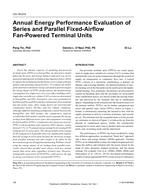Description
Given the limited capacity of modeling fan-poweredterminal units (FPTUs) in EnergyPlus, an alternative modelfollowing the mass and energy balance approach was developedand implemented in Engineering Equation Solver (EES)to capture the terminal unit performance over a range of designoptions and operating characteristics. To evaluate the abilityof the alternative model for energy calculation and investigatethe energy impact of FPTU design options, the annual energyconsumption of a single-story, five-zone office building with asingle-duct variable-air-volume (VAV) system was determinedin EnergyPlus and EES. Parametric runs were performed inboth EnergyPlus and EES with the combination of two terminalunit fan motor types, three sizing factors for electronicallycommutated motors (ECMs), and five climate conditions.Although different modeling assumptions existed between theEnergyPlus and EES models, the comparative analysisrevealed that both models could be used to quantify the energysavings from different motor types and equipment oversizingfor fixed-airflow FPTUs. Compared to the energy use of seriesFPTUs with permanent split capacitor (PSC) motors, resultsshowed 3.5%-6.7% annual energy savings by increasing ECMsizing factors in series units. The energy benefit of increasingECM sizing factors in parallel units was significantly smallerthan the savings in series units because the electricity savingsfrom parallel terminal unit fans tended to be offset by theincreased energy use of supplemental heating. Without consideringthe energy impact of air leakage from parallel units,results showed that parallel units always used less annualenergy than series units regardless of motor type. However,strategically sized series ECM FPTUs could narrow the gapin energy use between series and parallel FPTUs.
Citation: 2018 Winter Conference, Chicago, IL, Technical Papers
Product Details
- Published:
- 2018
- Number of Pages:
- 11
- Units of Measure:
- Dual
- File Size:
- 1 file , 1.1 MB
- Product Code(s):
- D-CH-18-014




